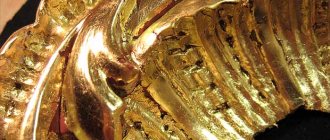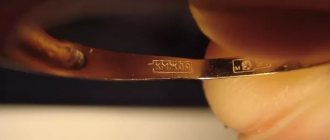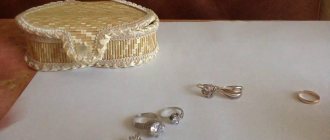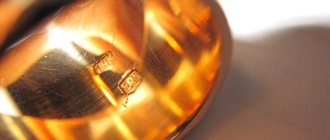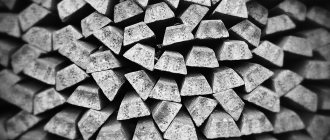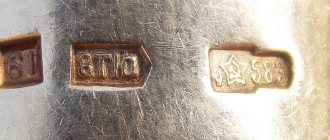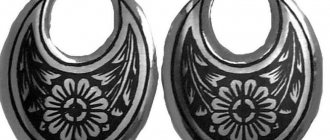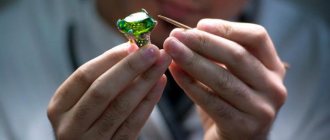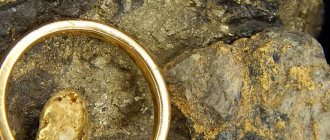Post updated: May 25, 2020
Products made from gold alloys of various grades are used not only as jewelry; parts made from precious metals are also actively used in industry. The use of pure gold in these cases is usually not economically justified; most often, only an external gold coating is required, which gives the element the necessary properties. Surface gilding is one of the main galvanic processes in jewelry, which allows giving the product the required decorative or technical characteristics. How is electroplated gold produced?
Gold plated jewelry
When they hear the word “jewelry,” many fashionistas imagine unremarkable plastic or metal jewelry that carries no value. High-quality costume jewelry cannot be classified as this type of product; even its base is made of cheap material. Craftsmen usually use base metals for the base of jewelry, and to give it an attractive appearance, they apply a beautiful coating using the galvanic method.
Cupronickel, bronze, brass, pewter or nickel silver are used to produce blanks for jewelry. All these alloys differ from each other in color characteristics and properties. Cupronickel is produced by alloying copper, iron, nickel and manganese. The result is an alloy similar in color to silver. Pewter is made from tin, which makes it easy to cast. Nickel silver is an alloy of zinc, nickel and copper, which, depending on the predominant element, acquires a tint of different shades. Bronze and brass contain copper, which makes their color quite attractive.
Craftsmen achieve the golden color and characteristic “precious” shine using electroplating. The base of the decoration does not have to be metal; it can also be a material of a non-metallic nature. During the galvanic process, the product is coated with a layer of gold or silver. In recent years, the rhodium procedure has often been resorted to.
Electroplating with gold provides the decoration with an attractive appearance. Reviews of such products are divided into two parts. Lovers of good jewelry speak positively, arguing that gold-plated jewelry has the effect of a precious metal, but for less money. High-quality coating and painstaking work of an experienced craftsman can bring the most daring design ideas to life. Others have a negative attitude towards products of this kind, since they only recognize precious jewelry.
Care, cleaning and storage of gold-plated items
In order for your jewelry to last as long as possible, you must follow a few simple rules for caring for gold plating.
| Wearing | Be sure to remove gold-plated jewelry before any contact with water (shower, swimming pool, washing dishes) or sports activities. Avoid contact with cosmetics. Don't forget that everyday wear shortens their service life. |
| Storage | Store only in a separate box or fabric bags so as not to damage the layer with other decorations. |
| Cleaning | Clean only with a soft cloth without using abrasives. If dark spots just appear, just wipe with ordinary vinegar and rinse in water. The shine will help return the egg white (after it you will also need to rinse in clean water). Once a year, items should be taken to a jeweler for professional cleaning. |
Despite the fact that sooner or later the coating wears off, it can always be renewed in a jeweler’s workshop.
Methods of applying gold plating
Among the possible options for applying gilding, experts distinguish two methods: mechanical and electrochemical. The mechanical method involves covering the surface with gold leaf. Gilding with the thinnest sheets of metal has been used since ancient times; over many centuries, the essence of the procedure has remained virtually unchanged. Gold leaf plating can be oil-based or glue-based; in the first case, the metal is glued to oil varnish, and in the second, to polyment. The oil-based coating turns out matte; to achieve the effect of a shiny surface, experts resort to using an adhesive base. Work on creating an adhesive coating can be carried out exclusively indoors, since such gilding is characterized by high sensitivity to moisture.
The electrochemical version of surface treatment with precious metal is a galvanic method of applying gold to a product. What it is? During the work, the master applies, using electric current, a thin layer of yellow precious metal, the size of which can reach fractions of microns.
Like any coating, electroplating has its advantages and disadvantages over other options. There are quite a few advantages of coating obtained in this way. These include a high level of wear resistance, excellent reflectivity, high current conductivity, the ability to protect the product from aggressive external factors, the effects of corrosive and oxidative processes. When applying galvanic coating, the specialist carrying out the work can control the thickness of the precious metal layer. Due to the listed properties, galvanic gilding is widely used both in surface decoration and for creating technical parts of devices.
Electrochemical deposition of gold on the surface.
For a long time, the main disadvantage of the method was considered to be the limited scope of its application. The electrochemical method of applying gold to a surface assumes that this surface is conductive, that is, made of metal. Thanks to scientific advances, this problem has now been partially resolved: special technologies make it possible to gild dielectric materials using conductive varnishes and films.
Work examples:
Gilding with gold leaf:
1
2
>
Gilding with gold leaf:
1
2
>
Gilding of stucco:
1
2
>
Gilding technology
Gold plating is a process of depositing a metal film. The thickness of the film can be different; depending on the purpose of gilding, a specialist can apply a layer on the product with a thickness ranging from a fraction of a micron to a fraction of a millimeter. The whole process is divided into three stages: first the surface must be prepared, then a layer of metal is applied and final processing is carried out.
A high-quality coating will only be achieved if the surface to be treated is well prepared. The product is pre-polished mechanically. To do this, use sandpaper, special pastes or grinding machines. Then the surface is degreased in an organic solvent. Alcohol, acetone or gasoline can cope with this task. Another mandatory procedure before galvanic treatment is pickling - removing existing contaminants, oxides and rust from the surface.
Sometimes it is necessary to electroplate only part of a part; for this, the remaining areas of the product must be protected from the effects of electrolyte and gold deposition. To do this, before applying the precious coating, acid-resistant varnish is applied to areas that are not subject to gilding.
The part is plated with gold using galvanic baths. The work is carried out using conductive suspensions and drums made of acid-resistant materials or in bell installations that ensure excellent electrical contact. The galvanic bath must also have an acid-resistant coating so as not to be destroyed under the influence of the electrolyte and equipment in the form of steam jackets. The entire process takes place at high temperature and the required current density, which are supported by automatic regulators. It is almost impossible to carry out galvanic procedures at home, since this requires not only special equipment, but also rare chemical reagents.
Upon completion of the work, the product is coated with a thin metal layer, which provides the best characteristics for the part. For decorative products, it is important to acquire an attractive appearance and the desired shade, for industrial parts - the ability to resist corrosion, improve electrical contact and facilitate the soldering process. Sometimes galvanic coating is used to increase the volume of a product. Depending on what properties need to be imparted to the part, electroplating can be done with both gold and other elements: silver, chromium, nickel.
Application of zinc contact
To obtain a thicker gold-plated layer, a zinc contact is used. Using this method, you can, for example, coat silver with a layer of gold. For gilding, a composition is prepared from the following components:
- gold chloride – 15 grams;
- carbonic potassium salt – 65 grams;
- yellow blood salt – 65 grams;
- table salt – 65 grams;
- water – 2 l.
It will take some time to dissolve all components of the composition
Products made of copper and brass are plated with gold in a solution of the following composition:
- gold chloride – 2 grams;
- caustic potassium – 6 grams;
- potassium cyanide – 32 grams;
- sodium phosphorus salt – 10 grams;
- water – 2 l.
Objects on the surface of which it is necessary to apply a layer of gilding are thoroughly cleaned of dirt and grease, then they are placed in a preheated gilding composition. The products already there are connected to a zinc rod, which acts as a contact.
Compositions of degreasing solutions
In order for the gilding applied to the surface of products made of steel, zinc and tin to be of high quality and have good adhesion, they must be subjected to a copper plating procedure before gilding.
Gold alloy plating
To coat products, gold alloys are most often used, to which a ligating component is added. An additional element in the alloy allows you to give the part the necessary qualities and the desired shade. In Russia, preference is given to gold with a reddish tint; in the USA and some other countries, priority is given to coatings of lemon yellow or brass shades.
In order for electroplating to have a tint not like gold, but like platinum, the working alloy must consist of gold and nickel, the percentage of which must be at least 8-10%. This coating will have a white tint and will also be highly hard compared to a pure gold layer. The higher the proportion of nickel in the alloy, the higher the hardness and wear resistance of the final surface will be. Electroplating based on gold and nickel is used abroad for jewelry. Due to their high resistance to corrosion processes, they can also be used for technical purposes.
An alloy of gold and copper is used in Russia to coat elements of wristwatches. The progress of the process depends on the concentration of free cyanide in the electrolyte: the higher the concentration of the substance in the electrolyte, the lower the copper content in the resulting coating. When the process is carried out under conditions of neutral electrolytes, a copper-gold coating with a thickness of 20 microns can be obtained.
In addition to the listed alloys, gold-silver and gold-antimony compositions are also used. The percentage of elements in the final coating depends on the characteristics of the electrolyte and the chemical reagents used.
Gold-antimony electroplating has earned positive reviews for its use in gilding eyeglass frames. A coating of this composition is characterized not only by increased wear resistance, but also by an attractive appearance. Depending on the thickness, it can turn out semi-shiny or shiny. Such properties, together with a high level of resistance to mechanical stress, allow the alloy to be used for decorative purposes.
Types of gilding in watchmaking and their features
Gilding of watches can be complete or partial. Both options have certain implementation features.
Full
Swiss watches with gold plated
In this case, all parts of the watch case are covered with gold – the bracelet, the dial, all the clasps. Spraying is applied in a layer of 3-20 microns.
Partial
Watches with partial gilding
In partial gilding, plating is applied only to the most significant part of the watch case. Usually - only on the outside of the bracelet. In this case, the inner side remains a different color.
Partial gilding is carried out due to the fact that the parts are subject to rapid abrasion. Approximately 1 micron of gold is erased per year, which causes the appearance of the product to deteriorate. Therefore, only visible parts are covered.
